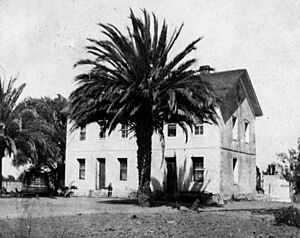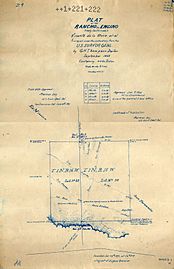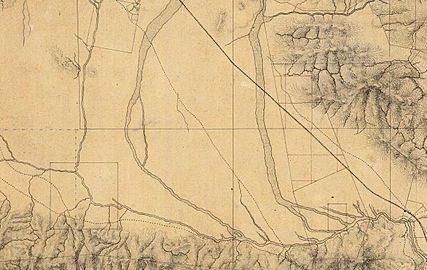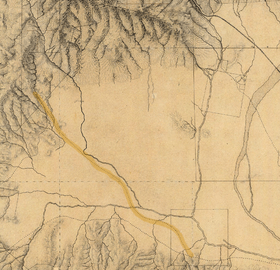Rancho Los Encinos facts for kids
Quick facts for kids |
|
|
Rancho El Encino
|
|
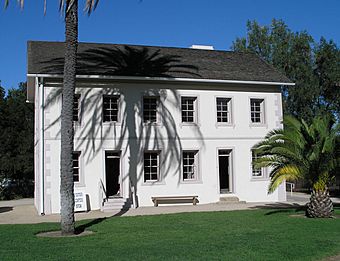
The limestone Garnier building at Rancho Los Encinos: restored from 1994 Northridge earthquake damages and now the park's Visitor Center.
|
|
| Location | Encino, California |
|---|---|
| Built | 1845 |
| Architectural style | Spanish Colonial, Basque vernacular |
| NRHP reference No. | 71000142 |
| Added to NRHP | February 24, 1971 |
Rancho Los Encinos (also known as Rancho El Encino or Rancho Encino) was a historic ranch in the San Fernando Valley in California. It started as a place where Spanish settlers could let their animals graze. Later, it became a Mexican land grant for raising cattle and sheep. It was also a popular stop for travelers on the famous El Camino Real road. Today, the original buildings from the 1800s and the natural warm springs are part of the Los Encinos State Historic Park.
Contents
History of Rancho Los Encinos
How the Rancho Got Its Name
The name Encino comes from the Spanish word for oak trees. When the Portolá expedition explored the valley in 1769, they called it El Valle de Santa Catalina de Bononia de los Encinos. This was because of the many native Valley Oak and Coast Live Oak trees growing there. You can still see these oak trees at the park today!
The natural springs on the land were very important. The Tongva people used them long ago. Later, the Portola expedition camped here. The springs were a vital stop for anyone traveling on El Camino Real and the Ventura Road.

Francisco Reyes, who was the mayor of Pueblo de Los Angeles from 1793 to 1795, first started Rancho Encino. Around 1797, he gave this land to the Catholic Church to build Mission San Fernando Rey de España. Reyes then moved his ranch to a new spot in the southern valley. This new ranch was about 4,460 acres and was located near El Camino Real, between the Los Angeles River and the Santa Monica Mountains.
In 1845, Mexican Governor Pío Pico gave the property to three Tongva Native American workers named Ramon, Francisco, and Roque. They raised cattle and grew corn on their land.
In 1849, Don Vicente de la Osa bought the property from the Tongva people. He built a 9-room adobe farmhouse between 1849 and 1850. This house still stands near the spring today. He officially owned the Rancho under U.S. California law in 1851.
Times of Growth and Change
The California Gold Rush in 1849 created a huge demand for beef. Ranchos in southern California, like Rancho Los Encinos, raised cattle and sent them north to feed the gold miners. But this cattle boom started to slow down around 1855. It became cheaper to bring cattle and sheep to California from the Midwest and Texas. A drought in 1856 also made things harder for the ranchos.
The De La Osa rancho was a popular stop for travelers on El Camino Real and Camino Nuevo. Visitors could expect a warm welcome at the ranch house. The Butterfield Overland Mail stagecoach route, which went between St. Louis, Missouri and San Francisco, passed through the rancho. The first stagecoach arrived in the fall of 1858. A new stagecoach route opened in 1861. It started at Rancho Los Encinos and went to Santa Barbara over the Santa Susana Pass. The rancho was a stagecoach stop until the railroad took over in 1875.
With the cattle market struggling and facing many debts, Don Vicente de la Osa turned his house into a roadside inn in 1859. He started charging guests for his famous hospitality. Don Vicente De la Osa passed away in 1861. His wife, Rita, sold the property to James Thompson in 1867. Thompson raised sheep on the rancho for two years.
In 1869, Thompson sold the property to two Basque brothers, Eugene and Phillipe Garnier. Eugene Garnier built a two-story limestone farmhouse. It looked like the family home they had in the French Basque Country. He also built a brick-lined pond shaped like a Spanish guitar to collect water from the spring. The Garnier brothers also raised sheep and were known for their high-quality fleece. However, they also faced financial problems and lost the property in 1878.
The property changed hands several times over the next twenty years. Simon Gless, a Basque man, bought it and later sold it to his father-in-law, Dominique ('Domingo') Amestoy, in 1889. The fields were used for wheat farming, which was common in the Valley after Isaac Newton Van Nuys introduced dryland farming. The Amestoy family lived on the property until 1945. They sold off about 1,170 acres of land in 1916, which became the community of Encino. They continued to sell off parts of the ranch after that.
After World War II, the San Fernando Valley grew very quickly. The old adobe house was even used as a sales office for new housing developments around it. There were plans to tear it down for new businesses. But neighbors who cared about the history fought to save the adobe and the spring. In 1949, the state of California bought the last remaining part of the ranch, including the historic buildings and the spring.
Los Encinos State Historic Park
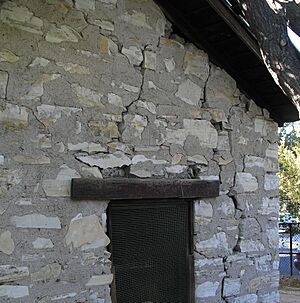
All the historic buildings in the park were badly damaged in the 1994 Northridge earthquake. The De la Osa adobe and the stone Garnier building have been repaired and restored. The Garnier building is now the park's visitor center. It has old photographs and displays about the rancho's past. The 1902 stone storage buildings, built for the Amestoys, still show signs of the earthquake. They are now used for park storage.
In 1984, during digging for a new building across Ventura Boulevard, archaeologists found a major Tongva village site. It was carbon-dated to be over 3,000 years old! They found two million artifacts, including stone tools, shell and stone beads, and arrowheads. They also found ancient burial remains. The park displays some of these very old artifacts.
In 2011, the State of California considered closing the park because it didn't make enough money to cover its costs. But thanks to the community and the Encino Neighborhood Council, an anonymous donor gave $150,000 to keep the park open.
The park is located at 16756 Moorpark Street, Encino, California, 91436-1068. It is open to the public from 10 AM to 5 PM, Wednesday through Sunday. There is also a walking entrance on Ventura Boulevard.
Map Gallery
-
Plat map of Rancho Los Encinos, based on an 1868 survey and registered for Eugene Garnier in 1873.
-
1880 manuscript map of the southeastern San Fernando Valley, with Rancho Los Encinos at the lower left and the Los Angeles River running southeast through the property.
-
The Butterfield Overland Mail stagecoach route highlighted from Rancho Los Encinos (bottom) to the Santa Susana Pass (upper left), on 1880 manuscript map of the western San Fernando Valley.






